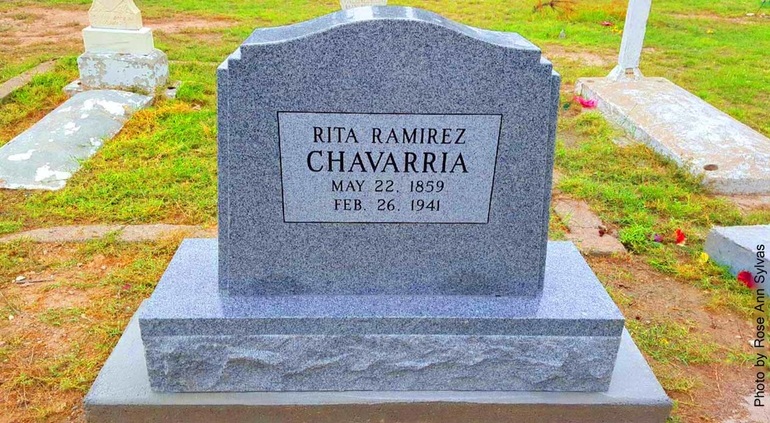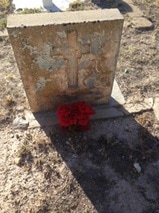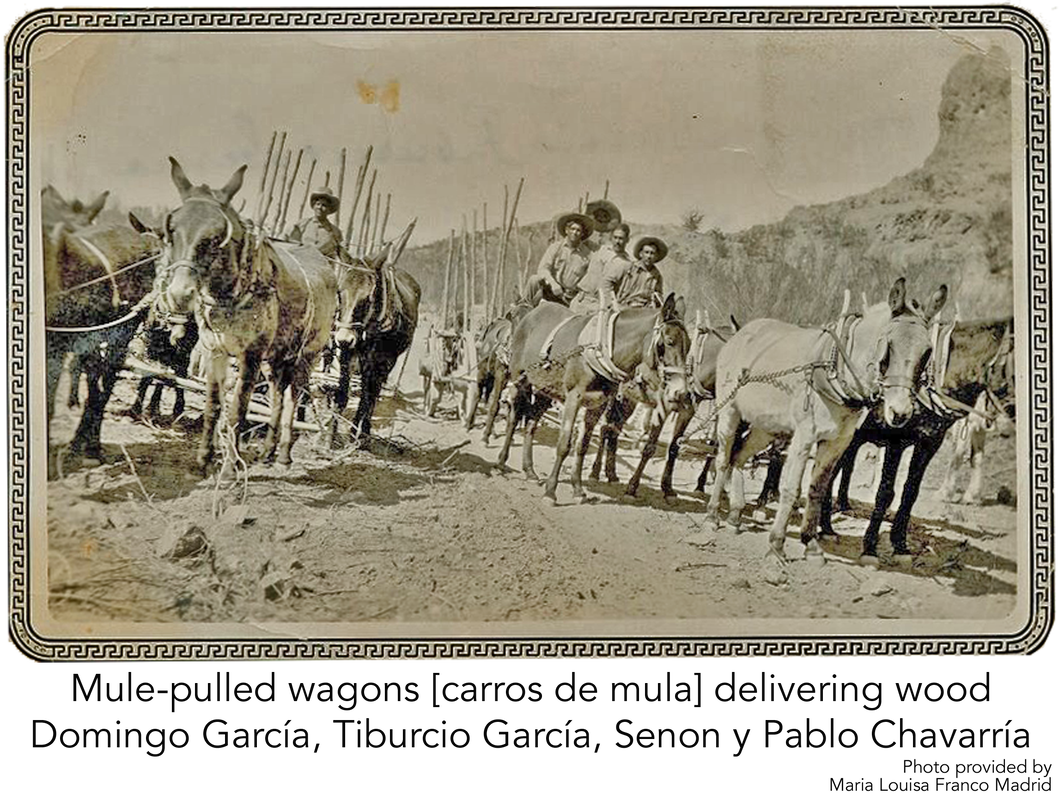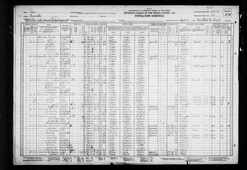Severiano Chavarría
|
Severiano Chavarría M4R5-6K5 (tree),
born May 1852 (1850 or 1851?) Baptized February 23, 1852 San Pablo, Meoqui, Chihuahua, MX died in 1925; buried in La Coyota, TX |
|
Severiano Chavarría married Rita Ramírez
on 7 Feb 1876 in Fort Stockton, TX
Location of Marriage record on FS is at
https://www.familysearch.org/ark:/61903/3:1:3QS7-994V-TKTH?i=24&cc=1803985
on 7 Feb 1876 in Fort Stockton, TX
Location of Marriage record on FS is at
https://www.familysearch.org/ark:/61903/3:1:3QS7-994V-TKTH?i=24&cc=1803985
Severiano and Rita had sixteen children including two sets of twins.
The first four children were born in Fort Stockton, Texas.
|
Pablo "Chiquito" (14) and Pablo "Gordito" (15) were twins.
1950 Census Pablo Chavarria in Alpine at
|

The Chavarría Story:
The Texas Republic became a state of the United States in 1845. So Texas had been part of the US for about 14 years when Rita Ramírez was born May of 1859 but what is now Pecos County was part of Presidio County at that time. Records show her birthplace as "Presidio" Texas. The use of the county to designate birthplace was not unusual when the birthplace was a settlement or town without a post office or other governmental recognition. So the designation of her birthplace as "Presidio" likely refers to the county she was born in, but her family likely was living in what was then known as St. Gall and is today's Fort Stockton.
The Texas Republic became a state of the United States in 1845. So Texas had been part of the US for about 14 years when Rita Ramírez was born May of 1859 but what is now Pecos County was part of Presidio County at that time. Records show her birthplace as "Presidio" Texas. The use of the county to designate birthplace was not unusual when the birthplace was a settlement or town without a post office or other governmental recognition. So the designation of her birthplace as "Presidio" likely refers to the county she was born in, but her family likely was living in what was then known as St. Gall and is today's Fort Stockton.
According to the Texas State Historical Association: "The land of Pecos County was originally in Bexar Territory and later part of Presidio County. Pecos County was established by the Texas legislature in 1871. The county was formally organized on March 9, 1875, at St. Gall, which became the county seat. There were 1,100 people living in the county that year. So Rita Ramirez was 12 years old when Pecos county was established and 16 years old when it was formally organized (became fully functional).
Rita married Severiano Chavarría in Fort Stockton where their first four children were born. Rita's next older sister, Donaciana Ramírez, who was born in Mexico, married Severiano's brother, Romaldo Chavarría. Both the Ramírez and the Chavarría families were living in Fort Stockton.
Severiano and his brother Romaldo Chavarría came from Mexico. Severiano was born in San Pablo Meoqui.
The area of San Pablo Meoqui and San Antonio Meoqui were referred to by Severiano as "Meoquis" when he told his grandson, Manuel Franco, where he came from in Mexico. There were families living in the area known as Junta de Los Rios (modern day towns Presidio/Ojinaga) for a long time. So many ancestors of Terlingua residents had been there a long time. But Meoqui, Julimes (about 11 miles north of Meoqui), and Delicias, Parral, and Valle Allende seem to be where many other ancestors of Terlingua residents came from.
Severiano and his brother Romaldo Chavarría came from Mexico. Severiano was born in San Pablo Meoqui.
The area of San Pablo Meoqui and San Antonio Meoqui were referred to by Severiano as "Meoquis" when he told his grandson, Manuel Franco, where he came from in Mexico. There were families living in the area known as Junta de Los Rios (modern day towns Presidio/Ojinaga) for a long time. So many ancestors of Terlingua residents had been there a long time. But Meoqui, Julimes (about 11 miles north of Meoqui), and Delicias, Parral, and Valle Allende seem to be where many other ancestors of Terlingua residents came from.

Click to expand
Severiano Chavarría and Rita Ramirez were married in Fort Stockton in 1876. Their marriage license was issued in February 1876 by Pecos County. Pecos County was not even a year old when Severiano and Rita got their marriage license. At that time the county seat was called Saint Gall. It was not renamed to Fort Stockton till five years later in August of 1881. It may seem confusing because the fort called Fort Stockton had already been there. The town next to the fort was called Saint Gall. Later the town was renamed Fort Stockton and the Fort ceased being an active fort so "Fort Stockton" referred only to the town. There is some evidence that some people lived around the Comanche Springs but not in Saint Gall. This might explain why many people used to refer to Fort Stockton as "Comanche" or "Comanchi." See a discussion on the name "Comanche" at http://www.familiasdeterlingua.com/6/post/2009/11/index.html
According to the Texas State Historical Association: "The land of Pecos County was originally in Bexar Territory and later part of Presidio County. Pecos County was established by the Texas legislature in 1871. The county was formally organized on March 9, 1875, at St. Gall, which became the county seat. There were 1,100 people living in the county that year.
According to the Texas State Historical Association: "In 1868 Peter Gallagher bought the land that included the military garrison and Comanche Springs, platted 160 acres for a townsite named Saint Gall, and established two stores at Comanche Springs. Later, Gallagher and John James purchased 5,500 acres along Comanche Creek. By 1870 the Saint Gall region had a population of 420 civilians, predominantly Irish, German, and Mexican Catholics who had come by way of San Antonio. The first church in Saint Gall was Catholic. When Pecos County was organized in 1875, Saint Gall became the county seat. The name, however, was never popular with the citizens, and on August 13, 1881, it was changed officially to Fort Stockton."
Although the quote above says that "420 civilians ...had come by way of San Antonio" as Peter Gallagher himself did. But that is not likely true for the "Mexicans."
So Rita and Severiano were married when the town of Fort Stockton had been in existence for only 18 years.
This copy of their marriage license issued by Pecos County in February of 1867 was provided by Maria Louisa Madrid who obtained it at the Pecos County offices.
According to the Texas State Historical Association: "The land of Pecos County was originally in Bexar Territory and later part of Presidio County. Pecos County was established by the Texas legislature in 1871. The county was formally organized on March 9, 1875, at St. Gall, which became the county seat. There were 1,100 people living in the county that year.
According to the Texas State Historical Association: "In 1868 Peter Gallagher bought the land that included the military garrison and Comanche Springs, platted 160 acres for a townsite named Saint Gall, and established two stores at Comanche Springs. Later, Gallagher and John James purchased 5,500 acres along Comanche Creek. By 1870 the Saint Gall region had a population of 420 civilians, predominantly Irish, German, and Mexican Catholics who had come by way of San Antonio. The first church in Saint Gall was Catholic. When Pecos County was organized in 1875, Saint Gall became the county seat. The name, however, was never popular with the citizens, and on August 13, 1881, it was changed officially to Fort Stockton."
Although the quote above says that "420 civilians ...had come by way of San Antonio" as Peter Gallagher himself did. But that is not likely true for the "Mexicans."
So Rita and Severiano were married when the town of Fort Stockton had been in existence for only 18 years.
This copy of their marriage license issued by Pecos County in February of 1867 was provided by Maria Louisa Madrid who obtained it at the Pecos County offices.
Family Oral Tradition:
Manuel Franco, grandson of Severiano, said Severiano had told him that one of his grandfathers was full blooded Native American. Severiano was a carpenter and said he built some of the early houses in Fort Stockton.
Manuel Franco, grandson of Severiano, said Severiano had told him that one of his grandfathers was full blooded Native American. Severiano was a carpenter and said he built some of the early houses in Fort Stockton.
Between May 30, 1884 and April 29, 1885, the Rita and Severiano family moved to the Big Bend area and are believed to have started La Coyota, Texas, a small settlement on the west bank of Willow Creek (also known as Alamo Creek) about two miles up the Rio Grande from Castolón. Severiano and Rita's remaining twelve children were born in La Coyota. [Click here to see a map of the Castolón area.] Bob Wirt and Louisa Madrid wrote in their Marcos Ramirez Documented Research Report "Severiano brought his family to the Castolón area from Fort Stockton around 1885 and settled at a site that later became known as La Coyota, about two miles west of Castolón. He was the earliest known settler in the area."
There is a report in the Texas State Historical Association's handbook of Texas online that tells how the area developed out of the economic activity in Castolón. However it erroneously states that Ruperto Chavarría led the group that started La Coyota, but in fact, Ruperto was only about eight years old when his father, Severiano Chavarría moved the family from Fort Stockton to the area. Rita moved back to Fort Stockton about 1938 because her death record states that she had been living in Fort Stockton for three years when she died. So Rita was born 1859 in Ft Stockton, she lived there and married Severiano in 1876. They had their first four children there. Then when Rita was about 25 years old they moved to what is now the Big Bend National Park and, according to Bob Wirt, they were founders of the settlement of La Coyota.
It is interesting that the 14th and 15th sons were twins and were given the same name: "Pablo." They were known by their nicknames "Pablo Chiquito," Little Pablo and "Pablo Gordito," Chubby Pablo. Around1950 Pablo "Chiquito" and his wife María Morales moved to Fort Stockton from Alpine where they had been living. It is not known when they left La Coyota for Alpine.
There is a report in the Texas State Historical Association's handbook of Texas online that tells how the area developed out of the economic activity in Castolón. However it erroneously states that Ruperto Chavarría led the group that started La Coyota, but in fact, Ruperto was only about eight years old when his father, Severiano Chavarría moved the family from Fort Stockton to the area. Rita moved back to Fort Stockton about 1938 because her death record states that she had been living in Fort Stockton for three years when she died. So Rita was born 1859 in Ft Stockton, she lived there and married Severiano in 1876. They had their first four children there. Then when Rita was about 25 years old they moved to what is now the Big Bend National Park and, according to Bob Wirt, they were founders of the settlement of La Coyota.
It is interesting that the 14th and 15th sons were twins and were given the same name: "Pablo." They were known by their nicknames "Pablo Chiquito," Little Pablo and "Pablo Gordito," Chubby Pablo. Around1950 Pablo "Chiquito" and his wife María Morales moved to Fort Stockton from Alpine where they had been living. It is not known when they left La Coyota for Alpine.
Rita Chavarría's tombstone was installed in October 2015.
Rita Franco Sanchez, who was named after her grandmother, Rita Ramírez Chavarría, had wanted to place a tombstone at her grandmother's burial site in St. Joseph's cemetery for a long time. The problem was that it had been decades since anyone remembered where Mama Rita (as she was called by her family) was buried. St. Joseph's rectory was built right next to a creek and at one point there had been a flood that destroyed the church records with the burial plot's information.
|
The original tombstone for
Rita Ramírez Chavarría |
Rita Sanchez died in May 2011, but she had asked her husband, Juan Sánchez, to get a tombstone installed for her grandmother. Juan was at a loss on how to fulfill his wife's dream because no one knew where she was buried. Then Marissa Chavarría Singh contacted us through social media informing us that she knew where Mama Rita was buried.
Marissa's grandfather, Pablo "gordito" Chavarría, had made the original marker for his mother, Mama Rita. The information had worn off over the years. So Marissa showed Juan Sanchez where the site was and some months later this beautiful tombstone was installed. |

Acknowledgements:
Louisa Madrid and Bob Wirt provided the information for this page largely from their Marcos Ramirez Documented Research Report.
Additional information about La Coyota is from
Martin Donell Kohout, "CASTOLON, TX," Handbook of Texas Online (http://www.tshaonline.org/handbook/online/articles/hrc31), accessed April 16, 2012. Published by the Texas State Historical Association.
Louisa Madrid and Bob Wirt provided the information for this page largely from their Marcos Ramirez Documented Research Report.
Additional information about La Coyota is from
Martin Donell Kohout, "CASTOLON, TX," Handbook of Texas Online (http://www.tshaonline.org/handbook/online/articles/hrc31), accessed April 16, 2012. Published by the Texas State Historical Association.
Click here to go to the Facebook "Severiano Rita Chavarría" page started February 2012 by Alicia Chavarría and Vicky Rodríguez.
Click here to go to the Chavarría Discussion Post in Familias de Terlingua.
Click here to go to the Chavarría Discussion Post in Familias de Terlingua.
Minor editing to clarify the story was done on December 17, 2022.
Minor updates to this page were made to correct incomplete information and add clarifying points on May 15, 2018.
Minor updates to this page were made to correct incomplete information and add clarifying points on May 15, 2018.




















